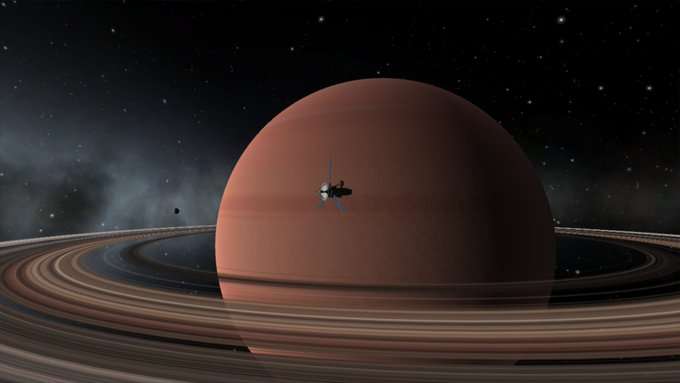
Introduction
Saturn, the stunning ringed planet, has always been a subject of fascination for scientists and space enthusiasts. Traditionally, missions to Saturn, like NASA’s Cassini spacecraft, have taken years to traverse the vast distance between Earth and the gas giant. However, groundbreaking advancements in propulsion technology could revolutionize space travel, potentially allowing us to reach Saturn in just two years. At the forefront of these advancements is the Direct Fusion Drive (DFD), a novel propulsion system that promises to cut travel times dramatically while offering numerous other benefits.
What is the Direct Fusion Drive?
Concept and Mechanics
The Direct Fusion Drive is a cutting-edge propulsion system being developed by the Princeton Plasma Physics Laboratory (PPPL) and Princeton Satellite Systems. Unlike conventional chemical rockets or even nuclear fission-based propulsion systems, the DFD relies on nuclear fusion, the same process that powers the sun. Fusion occurs when atomic nuclei combine at extremely high temperatures, releasing a vast amount of energy.
How It Works
The DFD utilizes a plasma confined by magnetic fields in a compact fusion reactor. In this reactor, deuterium and helium-3 (isotopes of hydrogen and helium, respectively) are fused together, producing a plasma that reaches temperatures of millions of degrees. The resulting fusion reactions generate not only heat but also charged particles. These charged particles are directed through a magnetic nozzle to produce thrust, propelling the spacecraft forward.
Advantages of the Direct Fusion Drive
Speed and Efficiency
One of the most compelling advantages of the DFD is its unprecedented speed and efficiency. Traditional propulsion systems require lengthy mission durations due to the limitations of chemical fuels. The DFD, on the other hand, offers a much higher specific impulse, meaning it can provide more thrust per unit of fuel. This high efficiency could reduce the travel time to Saturn from several years to just two years.
Continuous Thrust
Unlike chemical rockets that burn fuel in short bursts, the DFD can provide continuous thrust throughout the journey. This continuous acceleration and deceleration allow for more precise navigation and shorter travel times. It also means that the spacecraft can adjust its trajectory more effectively, improving mission flexibility.
Reduced Fuel Requirements
The DFD’s use of fusion fuel significantly reduces the amount of propellant required for long-distance missions. Deuterium and helium-3 are far more energy-dense than traditional chemical fuels, meaning that spacecraft equipped with DFD technology would need to carry less fuel, freeing up space for scientific instruments and payloads.
Potential Missions and Scientific Impact
Exploring Saturn’s Moons
A DFD-powered mission to Saturn could open new frontiers in the exploration of its moons, particularly Titan and Enceladus. Titan, with its thick atmosphere and hydrocarbon lakes, and Enceladus, with its subsurface ocean and geysers, are prime candidates for the search for extraterrestrial life. The reduced travel time would allow more frequent missions, enhancing our understanding of these enigmatic worlds.
Advancing Planetary Science
Rapid access to Saturn would enable more detailed and timely studies of the planet’s atmosphere, magnetic field, and ring system. This could lead to significant advancements in our knowledge of gas giants and their role in the solar system. Additionally, shorter mission durations reduce the wear and tear on spacecraft, potentially increasing the longevity and success rate of such missions.
Gateway to Deep Space Exploration
The DFD’s capabilities extend beyond Saturn. By proving the feasibility of rapid interplanetary travel, the DFD could pave the way for missions to more distant destinations, such as the outer planets and even interstellar space. This technology could serve as a stepping stone for humanity’s ambitions to explore the far reaches of our solar system and beyond.
Challenges and Future Development
Technical Hurdles
While the promise of the DFD is immense, several technical challenges remain. Achieving stable and sustained fusion reactions in a compact, space-ready reactor is a formidable task. Engineers and scientists are working diligently to overcome these hurdles, focusing on improving plasma confinement, magnetic field strength, and heat management.
Funding and Support
Developing and deploying the DFD will require substantial investment and support from both government space agencies and private enterprises. Collaboration between these entities is crucial for advancing the technology from the laboratory to space missions. Continued funding and international cooperation will be essential for the success of this revolutionary propulsion system.
Testing and Validation
Before the DFD can be used in a mission to Saturn, it must undergo rigorous testing and validation. Prototypes will need to demonstrate their performance in space-like conditions, proving their reliability and safety. Initial test flights and demonstrations will be critical steps toward achieving operational readiness.
Conclusion
The Direct Fusion Drive represents a paradigm shift in space travel, offering the potential to reach Saturn in just two years. This remarkable technology promises faster, more efficient, and more flexible missions, revolutionizing our approach to interplanetary exploration. While challenges remain, the progress being made in fusion propulsion is bringing us closer to a future where rapid access to distant worlds is a reality. As we stand on the cusp of this new era, the DFD symbolizes humanity’s relentless pursuit of knowledge and our enduring quest to explore the cosmos.
